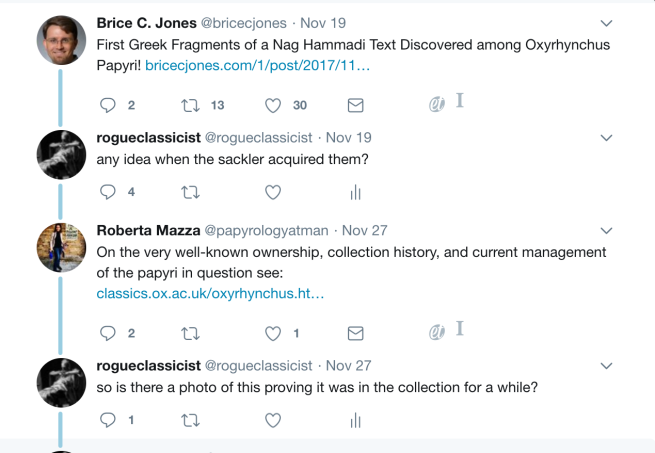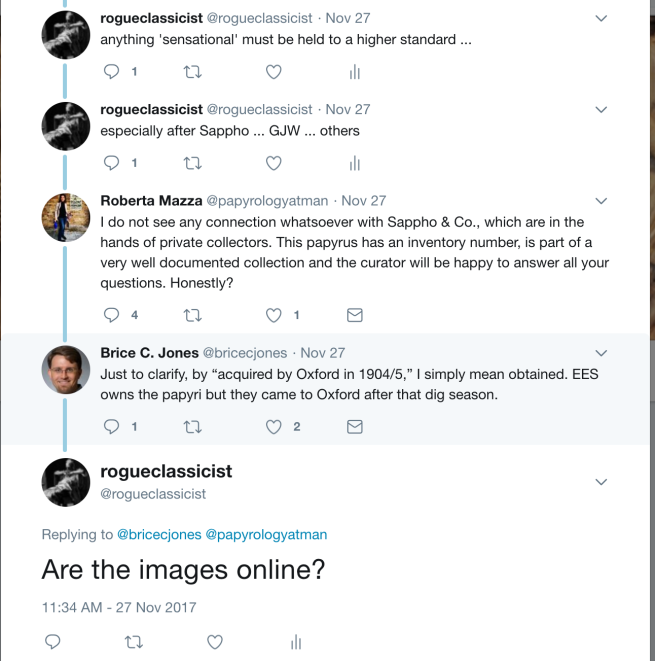A press release from the University of Warwick, with a nice photo too (and references!):
Over 2000 years ago Romans were celebrating the New Year in much in the same way that we do today with parties, drinking, gifting and, of course, with hopes for the year ahead. Roman celebrations were part of a religious festival called Saturnalia.
This winter festival originated as a farmers’ festival dedicated to Saturn, the Roman god of agriculture and the harvest.
Beginning on the 17th December and lasting between three and seven days, Saturnalia was when work and business stopped (Lucian, Saturnalia, 13) – and was the most popular holiday of the year with the poet Catullus calling it ‘the best of days’. (Catullus, Carmen, 14)
Kevin Butcher, Professor of Roman history at the University of Warwick, says that “the festivities appear to have extended to everyone, including slaves, and there is the idea of a world turned upside down, with masters allowing servants freedoms, or even dining with them, and perhaps even waiting on them”.
Until 153 BC the Roman New Year began on 1st March, however thereafter it was moved forward to 1st January. This date was then confirmed by the Julian Calendar in 46 BC, introduced by Julius Caesar.
While we make our New Year’s resolutions, Romans were lazier and looked to the gods to grant their wishes. Romans would make prayers and sacrifices to Saturn in the hope of good fortune for the coming year.
Lucian’s Saturnalia contains a dialogue between Saturn and a priest, in which the latter gives an extensive list of his New Year’s wishes. He asks for the ‘obvious things—wealth, a lot of gold, to be lord of an estate, to own many slaves, clothing, bright-coloured and soft, silver, ivory, and everything else that is worth something’, but Saturn responds that the request is beyond him and that he should try his luck with Zeus instead. (Lucian, Saturnalia, 1)
The Roman historian Livy even records a human sacrifice during the Saturnalia of 217 BC. ‘Victims were slain at the temple of Saturn in Rome’ in order to muster favour with the gods during the Second Punic War following the military success of Hannibal. (Livy, History of Rome, 22.1.19)
Nowadays gift-giving is most commonly associated with Christmas, however Romans used this practice to celebrate the New Year. These gifts ranged from the modest to the extravagant and were sometimes bizarre.
Rather than a partridge in a pear tree and Lords-a-Leaping, according to the poet Martial, gifts included perfumes, sausages, dice, wine, hair, ear pics, sponges, bladder footballs, woollen slippers, parrots and sheep’s heads. (Martial, Epigrams, 14).
 One such gift is a terracotta oil lamp dated to the second half of first century AD, which depicts the Roman goddess Victory alongside examples of New Year’s gifts: dates, figs, and coins and bearing the inscription ‘A happy and prosperous New Year!’
One such gift is a terracotta oil lamp dated to the second half of first century AD, which depicts the Roman goddess Victory alongside examples of New Year’s gifts: dates, figs, and coins and bearing the inscription ‘A happy and prosperous New Year!’
Romans had a strong tradition of giving silly gifts which probably accounts for the number of complaints from recipients during Saturnalia. Martial detests the cheap quality of the gifts he receives from his friend Umber, who was recycling his own unwanted presents. He grumbles that he has been gifted ‘everything which you have received during the past five days’. (Martial, Epigrams, 7.53)
Likewise, when Catullus receives an excruciatingly bad book of poems as a joke from his friend Calvus, he moans ‘what have I said or done to deserve it / that you’re killing me now with all these poets?’ (Catullus, Carmen, 14)
Gift giving at New Year is still practiced in many countries including France, Russia and Turkey and is also part of Hogmanay in Scotland.
It is clear that Romans also enjoyed a party with which to end the year. The celebrations of 217 BC in Rome were particularly wild, as Livy records that ‘throughout the City for a day and a night “Saturnalia” was cried’. (Livy, History of Rome, 22.1.20)
However, not everyone approved of this unrestrained revelry. The philosopher and statesman Seneca complains that ‘the whole mob has let itself go in pleasures’. (Seneca, Epistles, 18.3)
The state in which many a Roman would end a night’s festivities is effectively described by Lucian, ‘now I faint, and drunken with thy liquor drag myself at last to sleep’. (Lucian, Saturnalia, 2) Such sentiments, many a New Year’s Eve party-goer will be familiar with no doubt.
Others, like Pliny the Younger, preferred a quiet night in. ‘During the Saturnalia, when all the rest of the house rings with the merriment and shouts of the festival-makers’ he would take delight in the quiet of his sitting-room and engross himself in his studies. (Pliny the Younger, Letters, 2.17.24)
However the festival still remains somewhat of a mystery as Professor Kevin Butcher notes that “for a ceremony of such importance in the Roman calendar it is surprising how little information about it survives.”


